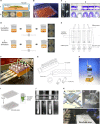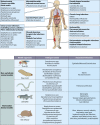Options and Limitations in Clinical Investigation of Bacterial Biofilms
- PMID: 29618576
- PMCID: PMC6056845
- DOI: 10.1128/CMR.00084-16
Options and Limitations in Clinical Investigation of Bacterial Biofilms
Abstract
Bacteria can form single- and multispecies biofilms exhibiting diverse features based upon the microbial composition of their community and microenvironment. The study of bacterial biofilm development has received great interest in the past 20 years and is motivated by the elegant complexity characteristic of these multicellular communities and their role in infectious diseases. Biofilms can thrive on virtually any surface and can be beneficial or detrimental based upon the community's interplay and the surface. Advances in the understanding of structural and functional variations and the roles that biofilms play in disease and host-pathogen interactions have been addressed through comprehensive literature searches. In this review article, a synopsis of the methodological landscape of biofilm analysis is provided, including an evaluation of the current trends in methodological research. We deem this worthwhile because a keyword-oriented bibliographical search reveals that less than 5% of the biofilm literature is devoted to methodology. In this report, we (i) summarize current methodologies for biofilm characterization, monitoring, and quantification; (ii) discuss advances in the discovery of effective imaging and sensing tools and modalities; (iii) provide an overview of tailored animal models that assess features of biofilm infections; and (iv) make recommendations defining the most appropriate methodological tools for clinical settings.
Keywords: animal host models; biofilms; flow cells; imaging; quantification.
Copyright © 2018 American Society for Microbiology.
Figures















References
Publication types
MeSH terms
LinkOut - more resources
Full Text Sources
Other Literature Sources
Molecular Biology Databases
Miscellaneous

